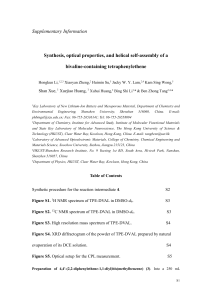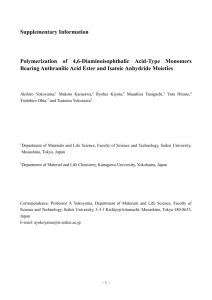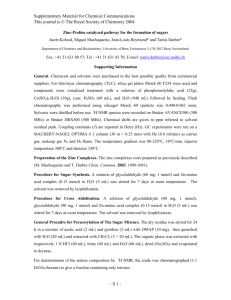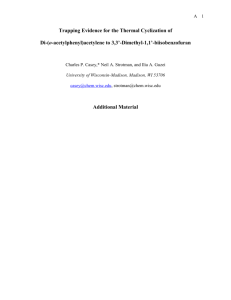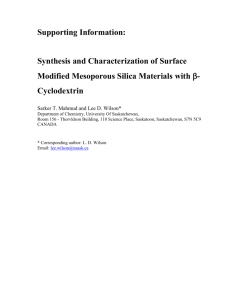Enol ethers have been considerable synthetic intermediate in
advertisement
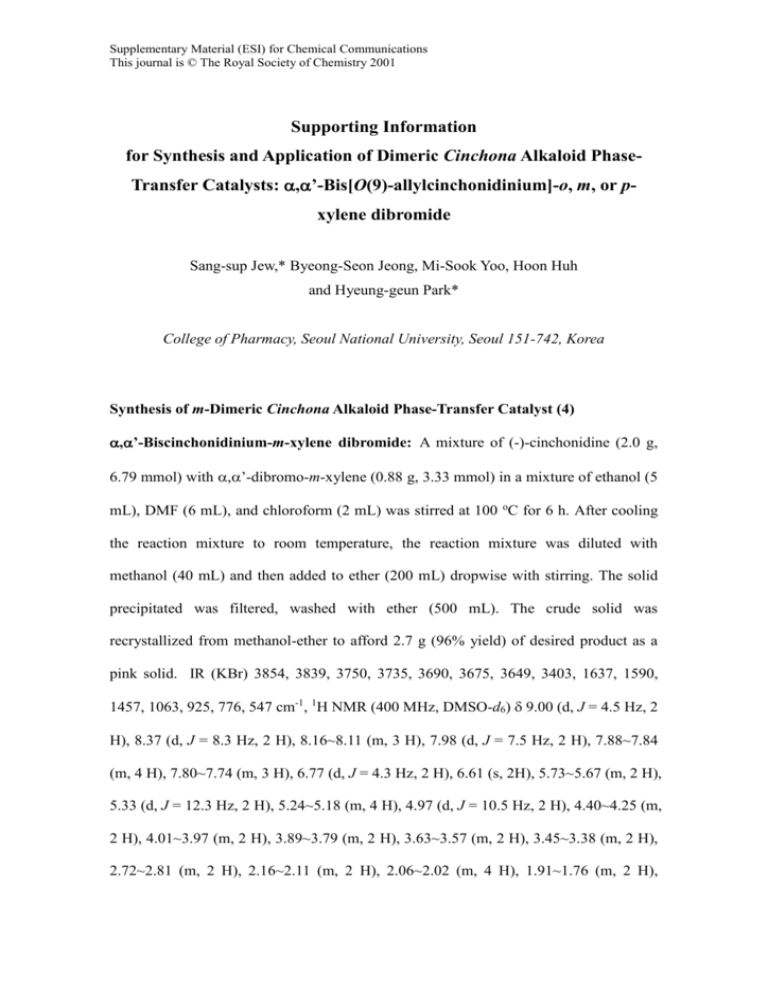
Supplementary Material (ESI) for Chemical Communications This journal is © The Royal Society of Chemistry 2001 Supporting Information for Synthesis and Application of Dimeric Cinchona Alkaloid PhaseTransfer Catalysts: ,’-Bis[O(9)-allylcinchonidinium]-o, m, or pxylene dibromide Sang-sup Jew,* Byeong-Seon Jeong, Mi-Sook Yoo, Hoon Huh and Hyeung-geun Park* College of Pharmacy, Seoul National University, Seoul 151-742, Korea Synthesis of m-Dimeric Cinchona Alkaloid Phase-Transfer Catalyst (4) ,’-Biscinchonidinium-m-xylene dibromide: A mixture of (-)-cinchonidine (2.0 g, 6.79 mmol) with ,’-dibromo-m-xylene (0.88 g, 3.33 mmol) in a mixture of ethanol (5 mL), DMF (6 mL), and chloroform (2 mL) was stirred at 100 oC for 6 h. After cooling the reaction mixture to room temperature, the reaction mixture was diluted with methanol (40 mL) and then added to ether (200 mL) dropwise with stirring. The solid precipitated was filtered, washed with ether (500 mL). The crude solid was recrystallized from methanol-ether to afford 2.7 g (96% yield) of desired product as a pink solid. IR (KBr) 3854, 3839, 3750, 3735, 3690, 3675, 3649, 3403, 1637, 1590, 1457, 1063, 925, 776, 547 cm-1, 1H NMR (400 MHz, DMSO-d6) 9.00 (d, J = 4.5 Hz, 2 H), 8.37 (d, J = 8.3 Hz, 2 H), 8.16~8.11 (m, 3 H), 7.98 (d, J = 7.5 Hz, 2 H), 7.88~7.84 (m, 4 H), 7.80~7.74 (m, 3 H), 6.77 (d, J = 4.3 Hz, 2 H), 6.61 (s, 2H), 5.73~5.67 (m, 2 H), 5.33 (d, J = 12.3 Hz, 2 H), 5.24~5.18 (m, 4 H), 4.97 (d, J = 10.5 Hz, 2 H), 4.40~4.25 (m, 2 H), 4.01~3.97 (m, 2 H), 3.89~3.79 (m, 2 H), 3.63~3.57 (m, 2 H), 3.45~3.38 (m, 2 H), 2.72~2.81 (m, 2 H), 2.16~2.11 (m, 2 H), 2.06~2.02 (m, 4 H), 1.91~1.76 (m, 2 H), Supplementary Material (ESI) for Chemical Communications This journal is © The Royal Society of Chemistry 2001 1.34~1.29 (m, 2 H) ppm; 13C NMR (100 MHz, DMSO-d6) 150.6, 148.1, 145.6, 139.3, 138.6, 135.7, 130.3, 129.9, 129.8, 129.0, 127.7, 124.7, 124.1, 120.6, 116.7, 68.1, 64.6, 62.6, 59.6, 51.0, 37.3, 26.3, 24.6, 21.5 ppm; m.p. 205 oC (decomp.); []D25 –171 (c 0.276, CH3OH); MS (ESI): 692 [M]2+; HRMS (ESI) calcd for [C46H52N4O2]2+: 692.4090, found: 692.4097. ,’-Bis[O(9)-allylcinchonidinium]-m-xylene dibromide (4): To a suspension of ,’-Biscinchonidinium-m-xylene dibromide (1.5 g, 1.76 mmol) in dichloromethane (5 mL) was added allyl bromide (1 mL, 11.56 mmol) and 50% aqueous KOH (2 mL, 17.6 mmol). The resulting mixture was stirred vigorously at room temperature for 4 h, during which time all of solids dissolved. The mixture was diluted with water (5 mL) and was extracted with dichloromethane (3 x 20 mL). The combined organic extracts were dried over MgSO4, filtered and concentrated in vacuo. The crude solid was recrystallized from dichloromethane-hexane to yield 1.5 g (94% yield) of desired product as a light yellow solid. IR (KBr) 3437, 2922, 1590, 1508, 1456, 1235, 1068, 925, 805, 754, 660, 457, 419 cm-1; 1H NMR (400 MHz, DMSO-d6) 9.03 (d, J = 4.4 Hz, 2 H), 8.35 (d, J = 8.3 Hz, 2 H), 8.15 (d, J = 9.0 Hz, 3 H), 7.97 (d, J = 7.5 Hz, 2 H), 7.90~7.86 (m, 2 H), 7.81~7.76 (m, 3 H), 7.72 (d, J = 4.4 Hz, 2 H), 6.53 (s, 2 H), 6.22~6.16 (m, 2 H), 5.78~5.70 (m, 2 H), 5.49 (d, J = 17.2 Hz, 2 H), 5.37~5.28 (m, 4 H), 5.20~5.14 (m, 4 H), 4.99 (d, J = 10.5 Hz, 2 H), 4.46 (dd, J = 12.5, 5.3 Hz, 2 H), 4.06~4.03 (m, 6 H), 3.82~3.76 (m, 2 H), 3.69~3.64 (m, 2 H), 3.51~3.40 (m, 2 H), 2.84~2.75 (m, 2 H), 2.34~2.26 (m, 2 H), 2.15~2.00 (m, 4 H), 1.92~1.81 (m, 2 H), 1.51~1.42 (m, 2 H) ppm; C NMR (100 MHz, DMSO-d6) 150.6, 148.4, 141.7, 139.3, 138.3, 135.9, 134.6, 13 Supplementary Material (ESI) for Chemical Communications This journal is © The Royal Society of Chemistry 2001 130.3, 130.0, 129.9, 128.8, 127.9, 125.4, 124.1, 120.0, 118.0, 116.9, 72.3, 69.7, 68.2, 63.4, 59.3, 51.2, 26.3, 24.5, 21.2 ppm; m.p. 181 oC (decomp.); []D25 –156 (c 0.320, CHCl3); MS (ESI): 772 [M]2+; HRMS (ESI) calcd for [C52H60N4O2]2+: 772.4716, found: 772.4739. Representative Procedure for Enantioselective Catalytic Alkylation of N(Diphenylmethylene)glycine tert-butyl ester 6 under Phase-Transfer Conditions (Benzylation): To a mixture of N-(diphenylmethylene)glycine tert-butyl ester 6 (50 mg, 0.17 mmol) and chiral catalyst 4 (8 mg, 0.0085 mmol) in toluene/chloroform (volume ratio = 7:3, 0.75 mL) was added benzyl bromide (0.1 mL, 0.85 mmol). The reaction mixture was then cooled (-20 oC), 50% aqueous KOH (0.25 mL) was added, and the reaction mixture was stirred at –20 oC until the starting material had been consumed (5 h). The suspension was diluted with ether (20 mL), washed with water (2 x 5 mL), dried over MgSO4, filtered and concentrated in vacuo. Purification of the residue by flash column chromatography on silica gel (hexane:EtOAc = 50:1) afforded the desired product 7g (61 mg, 94% yield) as a colorless oil. The enantioselectivity was determined by chiral HPLC analysis (DAICEL Chiralcel OD, hexane:2-propanol = 500:2.5, flow rate = 1.0 ml/min, 23 oC, = 254 nm, retention times; R (minor) 12.2 min, S (major) 22.5 min, 95% ee) The absolute configuration was determined by comparison of the HPLC retention time with the authentic sample synthesized by the reported procedure.4,5,6,7 Supplementary Material (ESI) for Chemical Communications This journal is © The Royal Society of Chemistry 2001 Characterization of New Alkylation Products. Entry h in Table 2; [R = 4-(tert-butyl)benzyl] Colorless oil. IR (neat) 3444, 2963, 1732, 1621, 1446, 1367, 1285, 1149, 779, 696, 457, 419 cm-1; 1H NMR (400 MHz, CDCl3) 7.63~7.61 (m, 2 H), 7.41~7.33 (m, 4 H), 7.28~7.23 (m, 4 H), 7.01~6.99 (m, 2 H), 6.57~6.56 (m, 2 H), 4.18~4.11 (m, 1 H), 3.24~3.15 (m, 2 H), 1.47 (s, 9H), 1.32 (s, 9 H) ppm; 13 C NMR (100 MHz, CDCl3) 171.0, 170.8, 149.1, 137.5, 136.2, 135.1, 132.3, 130.0, 129.5, 128.7, 128.2, 127.9, 127.6, 125.3, 124.9, 81.0, 68.0, 38.8, 34.3, 31.3, 28.0 ppm; []D25 –128 (c 0.392, CHCl3); MS (FAB): 442 [M+H]+; HRMS (FAB) calcd for [C30H35NO2 + H]+: 442.2746, found: 442.2742. The enantioselectivity was determined by chiral HPLC analysis (DAICEL Chiralcel OD, hexane:2-propanol = 500:2.5, flow rate = 0.5 ml/min, 23 oC, = 254 nm, retention times; S (major) 13.7 min, R (minor) 17.2 min, 95% ee). Entry k in Table 2; (R = cinnamyl) Colorless oil. IR (neat) 3445, 1732, 1622, 1446, 1367, 1148, 744, 694, 484, 415 cm-1; 1 H NMR (400 MHz, CDCl3) 7.35 (d, J = 7.1 Hz, 1 H), 7.69 (d, J = 7.1 Hz, 2 H), 7.53~7.52 (m, 1 H), 7.45~7.43 (m, 3 H), 7.37~7.28 (m, 5 H), 7.24~7.20 (m, 1 H), 7.19~7.16 (m, 2 H), 6.44 (d, J = 15.8 Hz, 1 H), 6.18~6.09 (m, 1 H), 4.18~4.11 (m, 1 H), 2.90~2.76 (m, 2 H), 1.49 (s, 9 H) ppm; 13 C NMR (100 MHz, CDCl3) 171.0, 170.8, 149.1, 137.5, 136.2, 135.1, 132.3, 130.0, 129.5, 128.7, 128.2, 127.9, 127.6, 125.3, 124.9, 81.0, 68.0, 38.8, 34.3, 31.3, 28.0 ppm; []D25 –37 (c 0.396, CHCl3); MS (FAB): 412 [M+H]+; HRMS (FAB) calcd for [C28H29NO2 + H]+: 412.2277, found: 412.2275. The Supplementary Material (ESI) for Chemical Communications This journal is © The Royal Society of Chemistry 2001 enantioselectivity was determined by chiral HPLC analysis (DAICEL Chiralcel OD, hexane:2-propanol = 500:2.5, flow rate = 1.0 ml/min, 23 oC, = 254 nm, retention times; S (major) 10.9 min, R (minor) 14.7 min, 90% ee).


